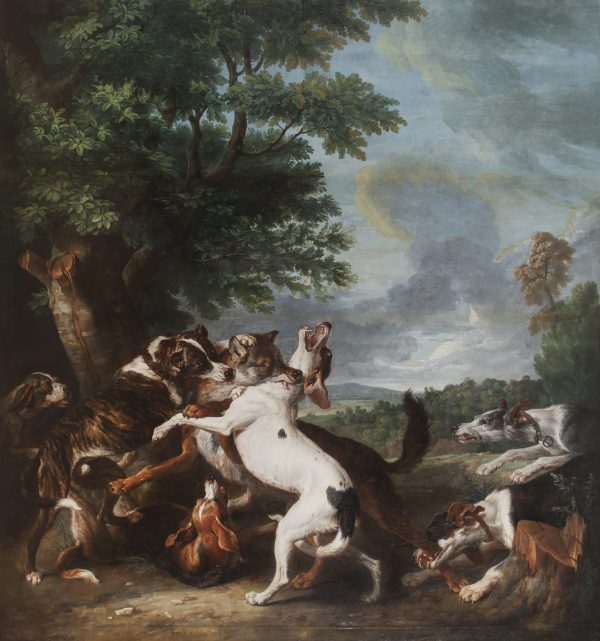Wolf Hunt, 1721
Oil on canvas, H. 2.5 m; W. 2.25 m
Signed and dated on lower right: Desportes 1721.
Provenance: Painted for the Pâris brothers (Hôtel de la Force in Paris)
Claude Pâris called La Montagne (château de Croixfontaine)
By 1742 with Etienne-Michel Bouret (from 1752 on in the Hôtel de la Grange Bâtelière, Paris)
M. de La Borde collection
From 1770 M. Grimod de la Reynière collection
Sale Galerie Georges Petit, 28 -29 May 1931, no. 196
Private collection, France.
G. de Lastic Saint Jal, P. Jacky, Desportes, Saint-Rémy-en-l’Eau, 2010, t. I (monograph), p. 181-182 (ill.), t. II (catalogue raisonné) p.175, n°P 654.
Alexandre-François Desportes was born in Champagne and rapidly became the pupil of the animal painter, Nicasius Bernaert. The early part of his career was spent painting decorative scenes, including theatre sets, and he also spent some time working at the château d’Anet and at Versailles for Louis XIV.
In 1695, he left for Poland where he was appointed Court Painter to King John Sobieski and painted portraits of him and other members of the royal family. After the death of the king in 1696, he returned to France and thereafter dedicated himself almost exclusively to hunting pictures. He became a Court Painter to Louis XIV, and decorated a large number of the royal residences, including the Château de Chantilly, the Hôtel de Bouillon, the Château de La Muette, the Château of Compiègne and the Château de Choisy. Desportes became a member of the Academy in 1699 and in 1704 was appointed Conseiller. In 1712, he travelled to England where he was greeted with great acclaim. On his return to France, he was commissioned by the Gobelins Tapestry Factory to design eight large hunting compositions. Commissions continued to pour in until his death in 1743.
This Wolf Hunt represents one of the four hunting scenes created in 1721 for the Pâris brothers, and probably for the Hôtel de la Force in Paris. Originally, at an unknown date, the painting was moved to the castle of Croixfontaine, the estate of Claude Pâris, called La Montagne, and then belonged to the fermier général Etienne-Michel Bouret who bought Croixfontaine around 1744. He placed this canvas, with its pendants, in the dining-room of his Hôtel de la Grange Bâtelière in Paris. The Wolf Hunt was then bought with the townhouse by La Borde, then by Grimod de La Reynière, who brought it to his new townhouse on the rue des Champs Elysées, now the rue Boissy d’Angla, where he lived from 1777. We lose track of the painting from 1828 when that townhouse became the Russian Embassy, then the Turkish Embassy in 1842. But it reappeared in George Petit’s Gallery in 1884 and then in a sale at the same gallery, on 28-29 May 1931, lot n°196 (with its pendants) and is still in the same family who bought it at that time.
